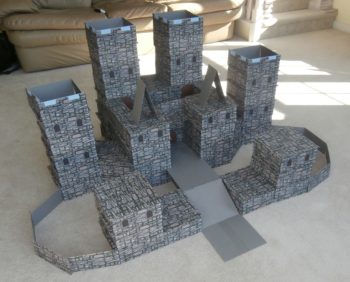
The fabulous sets of Kardtects makes it almost impossible to choose a favorite pack, many find it impossible and so collect them all. Each design seems to capture the imagination of fun and creativity, whilst linking it to passions of history or just periods that conjure adventure and childhood forging memories.
A great example of that could be of the Grisroc Set, with which you can build your own legendary castles, Gothic cathedrals and medieval cities, towns and landscapes. With options of flags and heraldry waiting to adorn the walls and roofs, it is easy to imagine knights, damsels and villagers running fetes and jousting competitions.

In 2016 the English Heritage organization raised a petition to have jousting recognized as an Olympic sport, yes, knights in armor, carrying long special spears, trying to knock each other off horses as they charge at each other.
One of the interesting dilemmas they may face is what rules will they use, and how would they deal with the cheats. Here are a couple of fun facts about this medieval sport…hope they make you smile. The next Olympics could be fun.
At one point the objective of ‘game’ was simply to knock your opponent off their horse. This obviously proved the courage and skill of each knight charging at each other. Yet, cheating knights, not adhering to the romantic notion of honor, began literally screwing their armor to the saddles!

For an alternative version, the rule was simply to see how many hits you could make, and for a hit to be considered good and strong, it would have to break (splintering) the lance (the special spear used in jousting). This should only happen when a lance hits the center of the opponents body so well that the force of the collision shatters the wood of the spear. As such, cheating knights began to make lances so fragile, or specially fractured, that the slightest ‘knock’ would break the weapon – the naughty knights!
So, it will be interesting, if jousting makes it to the Olympics, which rules will be adopted.
Did you also know that it is a commonly held belief that these knightly encounters are where the concept of saluting comes from?- When someone like a soldier draws their hand up to the forehead to acknowledge the presence of a superior officer.
The most commonly accepted idea of the origin of the military salute comes from a custom of when two knights were about to meet in combat, especially at jousting.

As we can appreciate, the common image of a knight is when wearing full metal armor, including a steel helmet to protect the head and face. These helmets were awkward things, whose design had to make a balance between productively protecting the head whilst not limiting the fighting effectiveness of the individual. The primary difficulty was to have the helmet solid enough to protect, but still allow the knight to see. So often, a good helmet covered the entire face, with just a few holes to see and breath.
The trouble with a face completely covered is it is difficult to be assured who it is you are about to fight. So the custom developed for a knight to reveal his face to their opponent before any combat. It was even more respected for a knight to show his face if he was about to fight someone who was higher up the social ladder, like, for example; a king.
As helmets were rather heavy bulky things, and awkward to get off, visors were added to the helmet, often hinged at the top, so that, instead of removing their helmet, a knight could just lift the visor up to expose his face.
With knights also wearing metal gauntlets, to open the flap on the front of the helmet, the knight would use the back of his hand and raise the visor upwards to his forehead to expose his face, again just a sign of respect and/or to acknowledge a combatant of a superior rank.
Besides this gesture echoing that of a modern salute, and the meaning behind it, another factor that draws a parallel with that medieval practice, is that, especially in England, a military salute is normally only given when the soldier is wearing their regimental headdress, or in other words – their ‘helmet’. (In England the only exclusion is the Blues and Royals (RHG/1stD); The Household Cavalry who, after The Battle of Waterloo, were allowed to salute without their regimental headwear).
So there are some Fun Facts for you!
Below is a video of a card castle being built! Maybe the winner of the joust gets to be the guest at a feast given inside!
